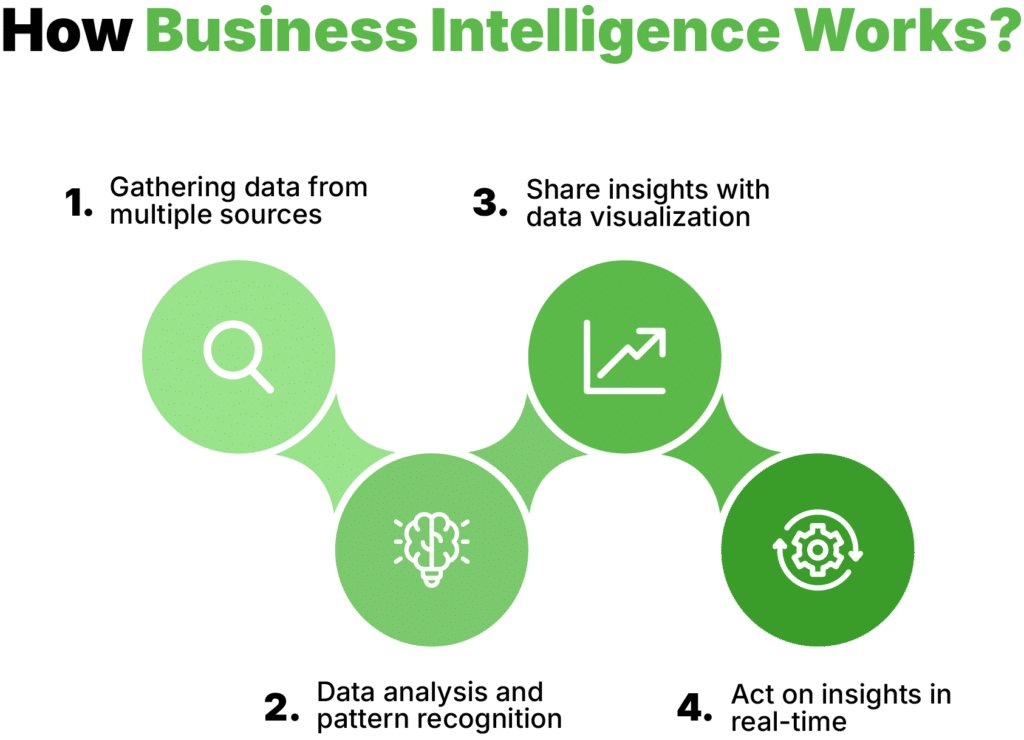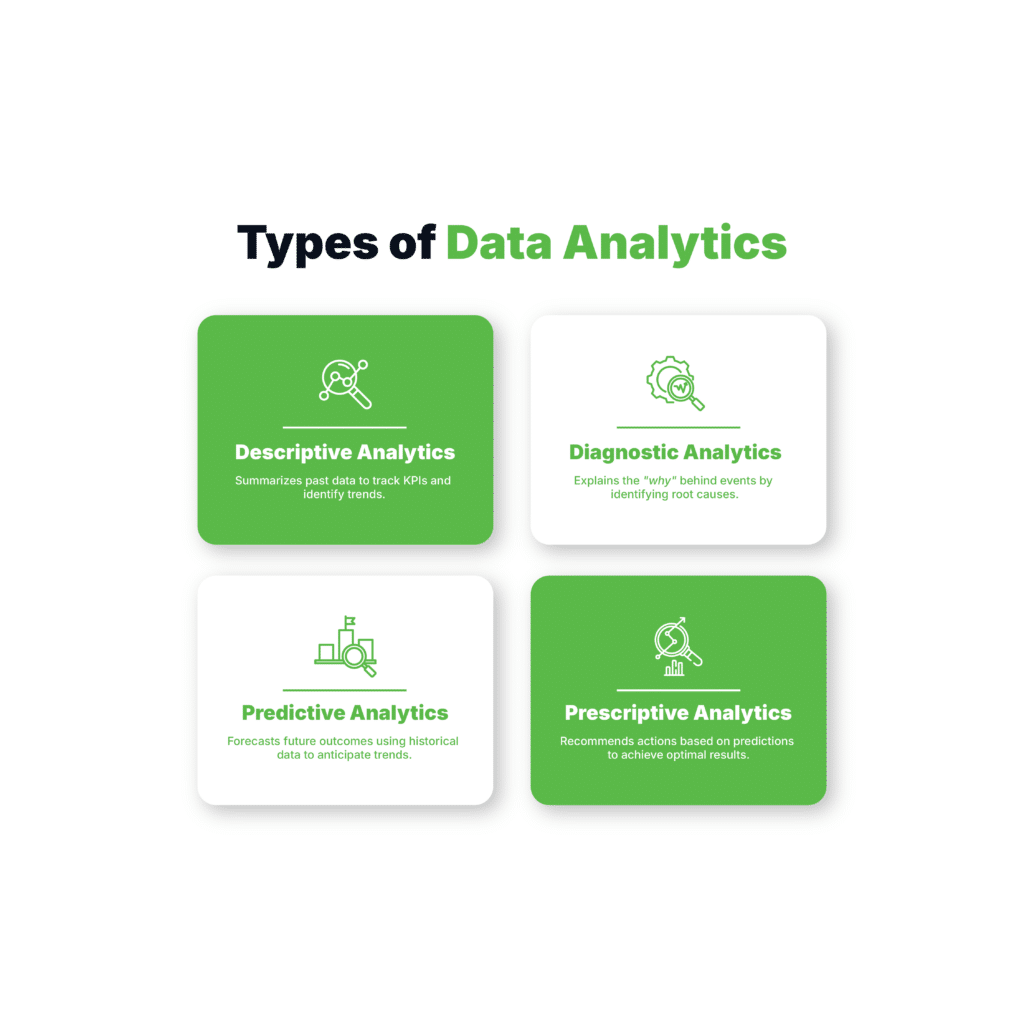
Data & AI Evangelist
Subscribe to the newsletter
Data speaks volumes, but making sense of it and turning it into meaningful action is where the real challenge lies. To bridge this gap, businesses rely on two powerful tools: business intelligence (BI) and data analytics.
Though often used interchangeably, these terms hold distinct roles in a company’s journey with data to interpret patterns, predict trends, and power smarter decisions. This subtle difference between analyzing information and making it actionable can decide between merely seeing what’s happening and truly understanding why it’s happening. When combined, Business intelligence and data analytics form a dynamic duo that empowers businesses to track progress, actively shape their strategies, respond proactively to trends, and gain a competitive edge.
This blog aims to uncover the difference between business intelligence and data analytics and how leveraging both can fuel impactful, data-driven growth.
What is business intelligence?
Business intelligence (BI) is a set of technologies, strategies, and practices used for collecting, analyzing, and presenting. Business intelligence aims to support better decision-making by gathering data from various sources, transforming it into a usable format, and visualizing it through dashboards and reports.
In the past, business intelligence tools were mainly in the hands of data analysts and IT professionals. Today, thanks to self-service BI platforms, everyone from executives to operations teams can access and use business intelligence. This democratization of data means that more people can explore insights and make informed decisions without needing specialized technical skills through business intelligence and analytics.
Business intelligence reporting tools deeply dive into historical and current data, turning complex information into clear, easy-to-understand visuals. This way, businesses can quickly access insights and trends at a glance, making it simpler to make informed decisions. This simplicity in decision-making is a key benefit of business intelligence, providing businesses with a sense of reassurance and ease in their strategic planning.
- Streamlined efficiency in operations that save time and resources
- Valuable insights into how customers shop and what influences their decisions
- Reliable monitoring of sales, marketing, and financial results to inform decision-making
- Establishing clear benchmarks based on both past and present data to measure progress
- Instant real-time alerts about any data irregularities or customer issues that need attention
- Collaborative analysis across departments, fostering teamwork and informed discussions.
More insights: Learn how to improve business intelligence and process efficiency with Microsoft AI Builder.
How does business intelligence analytics turn data into decisions?
As business intelligence analysts help businesses make sense of past performance, identify key metrics, and support real-time decision-making with a focus on descriptive insights, the question is: how does it really work? Business intelligence follows four key steps to turn raw data into clear, easy-to-understand insights from which everyone in the organization can use and benefit.
Let’s walk you through the step-by-step working of business intelligence, highlighting its key processes and how it transforms raw data into valuable insights for your organization.

Step 1: Data gathering from multiple sources
The first step in business intelligence is to bring together data from different sources and transform it into a form ready for analysis. BI tools use the ETL (Extract, Transform, Load) method to pull in structured and unstructured data from across the organization, transform it into a consistent format, and store it in one central location. Once stored in one central location, this data becomes easy to analyze, giving a complete view of the business that helps uncover valuable insights.
Step 2: Data analysis and pattern recognition
In this step, business intelligence tools analyze data to uncover patterns, trends, and anomalies. Data mining and statistical analysis are used to understand the business’s current situation better, forecast potential future trends, and generate useful recommendations.
Step 3: Share insights with data visualization
In this step, business intelligence leverages data visualization to present findings clearly and engagingly. Interactive business intelligence dashboards, charts, graphs, and maps make it easier for users to comprehend what’s happening in the business at a glance, facilitating better understanding and collaboration.
Get familiar: Importance of data visualization for effective communication.
Step 4: Act on insights in real-time
By viewing current and historical data alongside business activities, companies can seamlessly transition from insights to action. Business intelligence empowers organizations to make real-time adjustments and implement long-term strategic changes to eliminate inefficiencies, adapt to market shifts, resolve supply issues, and address customer concerns.
What is data analytics?
Data analytics is the process of collecting, processing and analyzing large sets of data to gain valuable insights and draw meaningful conclusions. By using various statistical and computational techniques, big data analytics helps organizations understand patterns, trends, and relationships within their data.
These techniques often involve using specialized tools and technologies, like machine learning algorithms, data visualization software, and big data analytics platforms, to help businesses make sense of their data, turning complex data into clear visuals and insightful predictions everyone can understand and act on. Data analytics can generally be broken down into four main types:

- Descriptive data analytics
This type focuses on summarizing past data to show what has already happened, helping organizations track key performance indicators and understand trends over time.
- Diagnostic analytics
It goes a step further to explain the why behind certain events or trends, identifying root causes and revealing patterns that help explain outcomes.
- Predictive data analytics
This type uses historical data to forecast future outcomes, allowing businesses to anticipate trends, customer behaviors, and potential risks.
- Prescriptive data analytics
The most advanced type, prescriptive analytics, recommends specific actions based on predictions, helping organizations decide on the best course of action to achieve desired outcomes.
Further reading: Leveraging big data for better business decisions: Best practices for Enterprise AI
Business intelligence vs data analytics: Modern tools for business growth
As data and AI transform the business landscape, business intelligence and data analytics remain foundational to data-driven growth. But if both revolve around data, what exactly sets them apart? While business intelligence helps organizations understand what has happened by analyzing past performance, data analytics goes a step further to uncover why it happened and predict what could happen next.
Let’s take a look at the comparison table to see how BI and data analytics differ yet work in tandem as essential tools for modern business success.
| Differentiator | Business Intelligence | Data Analytics |
| Primary focus | Historical insights | Predictive insights |
| Purpose | Reporting and monitoring for informed decision-making | Analyzing data patterns to make predictions and optimize processes |
| Approach | Descriptive and diagnostic: answers “what happened” and “why” | Predictive and prescriptive: answers “what will happen” and “how to make it happen” |
| Data types | Structured data but also incorporate unstructured through advanced platforms. | Structured, unstructured, and big data from various sources |
| Tools & techniques | Dashboards, scorecards, and ad-hoc reporting | Machine learning, statistical analysis, and predictive modeling |
| Data timeframes | Primarily focuses on historical and real-time data | Uses historical data to generate future predictions and actionable insights |
| Outcomes | Data summaries, visualized reports, and KPI tracking for daily and strategic insights | Deeper insights and predictions that inform strategy, product development, and optimization |
| Complexity of insights | Offers more accessible, user-friendly insights for broad use | Involves complex analytical methods that often require technical expertise |
Choosing the right strategy: Business intelligence, data analytics, or both?
There’s no universal answer to choosing between business intelligence and data analytics. The right approach depends on your business’s specific needs, goals, and the complexity of the data at hand. However, we have summarized two scenarios that can help you per your business interests.
- Business intelligence is well-suited for organizations focused on gaining a clear view of their current operations. It excels in providing descriptive insights that help teams visualize trends and track key performance indicators (KPIs).
- Data analytics is ideal for those looking to delve deeper into their data. If you aim to anticipate market shifts or understand customer behavior on a granular level, data analytics can provide the strategic foresight necessary for long-term planning.
The real power is in combining both business intelligence and data analytics. BI gives a current performance snapshot, while data analytics uncovers growth insights. Assessing your goals, resources, and data complexity will help you choose the best path, enabling informed decisions and sustainable growth.
Empower your business with data-driven confidence and precision
There’s no doubt about the fact that understanding and leveraging the unique strengths of business intelligence (BI) and data analytics is essential for any organization aiming to thrive. Instead of viewing business intelligence vs. data analytics as competing approaches, it’s more beneficial to see data analytics as a valuable tool that enhances business intelligence.
Confiz stands at the forefront of data and AI services, bridging the gap between raw data and actionable insights. With our expertise, we help businesses make informed decisions and build a data-driven culture. Connect with our experts today to assess your data strategy and unlock new growth opportunities. Email us at marketing@confiz.com to get started.



